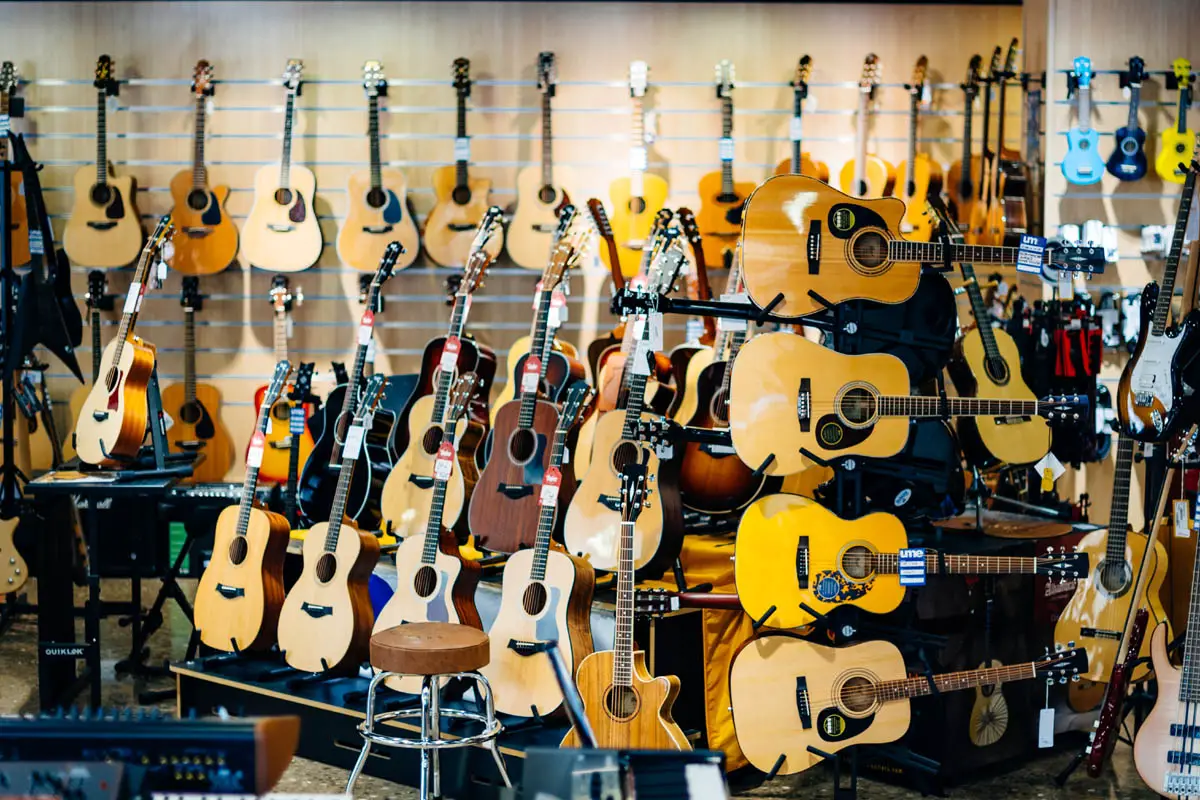What Makes an Acoustic Guitar Sound Good or Bad?
Picking up a few acoustic guitars in a store you soon realize that just because a guitar looks good on the outside it might not sound as good as others, but why?
There’s a lot that goes into making a good sounding acoustic guitar, and only a very little amount of that is the finish you see on the outside.
Some details that define good sounding acoustic guitars are:
- The types of wood used.
- Having a solid wood top.
- Scalloped internal bracing.
- The radius of the soundboard.
- The quality of the neck wood, and the join to the body.
- Correctly spaced and even height frets.
- A setup that gives good intonation and promotes sustain.
- The Combination of the Guitar’s Parts.
Whether you are looking for your next guitar and want to know what to look for, or have a guitar that you would like to make sound better, knowing more about these details will lead you in the right direction.
I’m going to lead you through the above areas to help you more easily find a good sounding guitar from the many models out there, and prevent you spending money on a dud.

1. The Types of Wood Used To Make the Guitar
The sound of an acoustic guitar is heavily influenced by the types of wood it is made from, with some woods sounding bright, and others having a dark tone.
Quite often a good sounding guitar will have different woods for the soundboard, back, sides, and neck that are designed to compliment each other.
If a guitar has a spruce top (very common for good acoustic guitars), then this produces a resonant bright tone, and often a wood like mahogany is used for the rest of the guitar to deepen the tone.
Guitars that have laminated back and sides (thin sheets of wood glued together) also do not resonate as freely as solid wood, and restrict the sustain and volume of the guitar.
The neck of a guitar transfers the string vibrations through to the body, and a good neck will have a straight grain and good wood density.
- The best back, side, and neck woods are usually rosewood or mahogany, which are strong woods that work well with spruce soundboards.
- Acoustic guitars made with basswood are best avoided, as this wood is not only too soft, but makes them sound very flat and dull.
Even knowing what woods are likely to sound good, two cuts of identical-looking wood can make guitars that sound very different.
2. Solid Wood Tops and Acoustic Guitar Sound
One of the most important parts of any acoustic is the top of the guitar, which is designed to amplify the sound of the vibrating strings.
Acoustic guitars with laminated tops are cheap to make and great for making strong guitars, but it doesn’t resonate very well, normally giving a flat boxy sound.
All acoustic guitars with a great sound will have a solid wood top, and can be made from a variety of woods depending on what sound the guitar maker wants from the guitar.
Spruce is commonly used because it has a great stiffness to density ratio, which enables it to radiate sound very efficiently.
The most prized steel string guitars will usually be made with European spruce or sitka spruce, while nylon string guitars use Western red ceder.
3. What Scalloped Internal Bracing Does
Most acoustic guitars use the same basic bracing pattern under the soundboard, with steel string guitars using the X bracing pattern, and nylon string guitars using fan-styled bracing.
Scalloped bracing is used on guitars to increase their dynamic range, so it doesn’t necessarily make a guitar sound better, but can really bring a guitar to life when played with less intensity.
4. The Radius of the Soundboard
This is not something you will be able to measure on a guitar you pick up, but is certainly one factor in the sound of an acoustic guitar.
The soundboard has a radius (outward belly) applied to it when it is built, and is formed by the shape of the bracing glued to its underside.
This is done to give the top extra strength to support the tension of steel strings, but can also tighten up the sound to give an improved tonal response.
A flatter soundboard can sound a little flatter with more bass, while a radiused top can often be more resonant with better attack.
This doesn’t apply to nylon string guitars, as due to their low tension strings they don’t require extra strength in the top.
5. Neck Quality and Sound
The neck of a guitar is very important for transferring the strings vibration energy into the body of the guitar, and 70% of the string vibrations travel along the neck.
Stiff neck woods transfer more energy to a guitar body, giving it more tonal character and better sustain.
Some people also claim that a thicker neck or larger headstock also improve the tone of a guitar, and while this can certainly be the case it can also depend on the body construction.
Maple is commonly used for good sounding guitar necks due to its stiffness and density, with mahogany being another favorite.
Of course there are other woods that can be used, but the common theme is that a good sounding guitar will have a neck wood that is stiff and dense.
6. Why Fret Spacing and Height Matters
Frets that are not set at the correct spacing from the bridge will have poor intonation that makes the guitar sound out of tune in different places on the neck.
Scale length refers to the distance of the furthest fret from the bridge, and each fret needs to be accurately spaced within this length to produce the most accurate notes possible.
With modern guitar making practices it’s hard to find a neck with poorly set frets spacing, however for some older guitars or super-cheap new guitars this could cause them to sound bad.
Fret height is important to allow a reasonably low playing action (string height), and uneven fret height will cause a guitar to sound bad with buzzing when playing at certain frets.
A good sounding acoustic guitar will have good fretwork that allows clear notes up and down the neck, and many cheaper guitars have poor sound due to string buzz on high frets.
7. Acoustic Guitar Setup for Good Sound
To get clear sounding notes that don’t sound sharp or flat, and ring out with good sustain, a guitar needs to be set up correctly.

The best sounding guitars will have a hard nut and saddle material which doesn’t dampen the string vibrations. A compensated saddle and correctly cut nut slots will ensure no string rattling on open notes, and good intonation so the guitar sounds well in tune.
Nut slot height also affects sound quality. High nut slots cause notes to sound sharp when played on lower frets, while low-cut nut slots cause string buzz on the first fret when played open (not fretted).
Correct neck relief will ensure that strings don’t buzz on the frets, and that the strings are a consistent height along the fretboard. Also, strings that need to be pushed down further to contact the frets can cause sharp sounding notes.
This is only a quick look at what a luthier can do with a good guitar setup to make a guitar sound better, but gives you an idea of why a guitar with a good setup will sound better.
8. A Guitar’s Sound is the Sum of Its Parts
Even though I have discussed the different parts of acoustic guitars here and how they can affect sound, at the end of the day it is all the parts together that make a guitar sound good.
A luthier can use a combination of woods to ‘build’ a tone that they want in an acoustic guitar, and so there are no hard-and-fast rules.
They can also apply different bracing variations, vary the scalloping in the bracing, or vary the thickness of the soundboard to give a different tone.
Great sounding guitars are not something you can spot with your eyes, and often two identical guitars will have slightly different sounds.
Acoustic guitars with good quality woods, good construction techniques, and a good setup will be the best sounding guitars. Just keep in mind that good tone is subjective, so a good sounding guitar to one person may not be considered so good by another.



